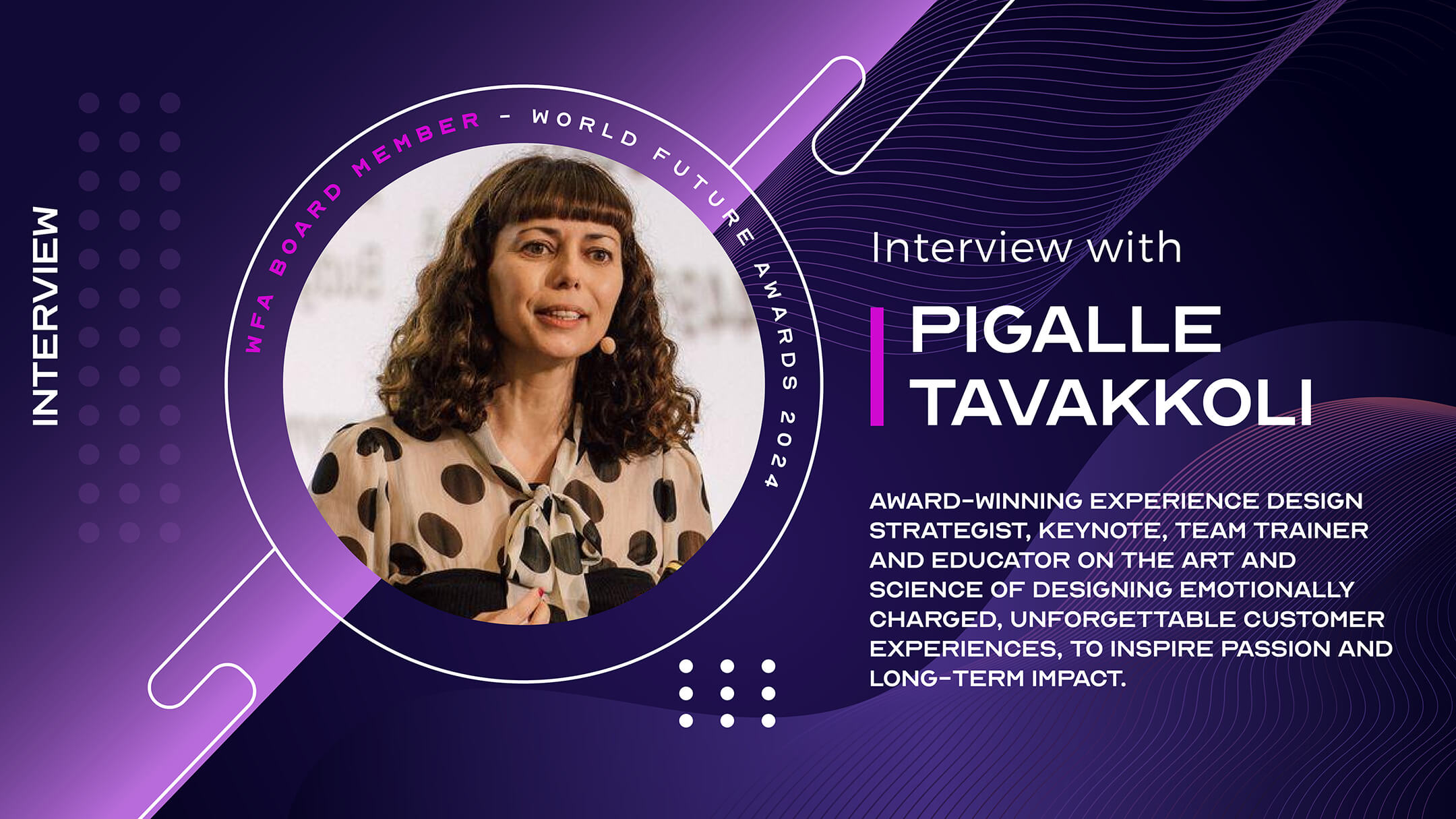
Pigalle Tavakkoli Joins the World Future Awards Board: Join our Exclusive Interview with the Experience Design Specialist
We are excited to welcome Pigalle Tavakkoli as the newest board member of World Future Awards. An award-winning Experience Design strategist, trainer, and educator, Pigalle spent 15 years as a producer facilitating collaborations between scientists and artists and devising storyworlds that merged live and digital platforms for cultural and scientific organizations, festivals, and brand activations across the UK and Europe. She has created a comprehensive experience design process and methods and provides training and consultancy for global brands such as Apple, The Guardian, and Unilever. Her unique approach combines art and science, strategic insight with creative vision, for lasting value and high-impact solutions for her clients.
Pigalle also co-developed and has been teaching the UK’s first course in Experience Design at the University of the Arts London for 12 years, and is the founder of the School of Experience Design. She is recognized as a thought leader and pioneer, as an international keynote and contributor to white papers and articles.
With accolades such as the Empowering Learning Journey Hero award for her innovative and impactful teaching methods, her roles as Council Member of the World Experience Organisation, and Jury Member for Conventa Best Event Award, Pigalle brings a wealth of expertise to the World Future Awards, where she will continue to shape the future of experience design.
We spent some time with Pigalle to learn more about her background, her accolades, and her vast experience.
World Future Awards: Congratulations on being selected as the newest board member of the World Future Awards! How do you see your experience contributing to the organization’s mission?
Pigalle Tavakkoli:
I’m delighted to join the board, thank you for the invitation. I’m passionate about designing meaningful experiences that empower people to reach their potential and drive impact, and excited to collaborate and cross-pollinate expertise, approaches and perspectives with the other board members.
I resonate with the World Future Awards mission to support the world to become better, smarter, and especially a more playful place to live in. As board members, we have a responsibility to shine the spotlight on individuals, projects, and organizations who are carving paths to achieve this, and I’m looking forward to supporting others to shine.
WFA: As an expert in Experience Design, how do you think the future of customer and client experiences will evolve over the next decade, especially in a world that’s becoming more digitally driven?
PT: We’re living in an era of accelerating changes with disruption is the new normal. This means that customer and client needs are also rapidly changing, and we need to keep up with their shifting priorities and motivations. However, there is a core human need that remains constant, which is the need for connection to ourselves, each other, and wider society for our lives to have meaning and purpose. As our lives become more intimately digitally intertwined, a gap is growing between ourselves and each other, which leads to increasing isolation and disconnection. This presents us with an opportunity to design digital experiences that humanize and bridge the divide so that digital systems become an enabler not a breaker of connection.
WFA: You’ve worked with major global brands like Apple, The Guardian, Pukka Herbs, and Unilever. Can you share a specific example where your approach to Experience Design led to a significant shift in how a brand connects with its audience?
PT: When I speak with and listen to an organization and their teams, they share the audience or client challenges they’re concerned about. Often these turn out to be symptoms, and when I follow their signals, I discover the underlying causes. This allows me to develop bespoke training to unblock the root challenges and release the team’s potential for the organization to thrive.
For instance, one organization thought a key challenge was that their teams needed to better understand the client brand stories to secure more pitches. However, I discovered the teams did understand the client brand stories well, and the reason why connections weren’t forming was due to their definitions and understanding of storytelling. This meant that each person used this in different ways across pitches, and consequently, this became confusing for the client. So I unified the department on the meaning and structures of story and narrative, and how to apply this to their proposals, for a cohesive message which would be clear for clients to understand.
The Director of Delivery responded by saying, “It was incredibly informative and you very clearly defined narrative as separate to the story. It was really useful for interrogating a brief and identifying the gap between what brands want from their
audience and vice versa, and how to bridge this. Everyone really engaged with this.”, with their Creative Director saying it was, “the best training this year”.
WFA: The concept of ‘emotionally charged’ experiences is central to your work. Could you elaborate on how emotions play a crucial role in shaping customer loyalty and long-term engagement?
PT: Emotions and memories are formed and stored in structures that sit alongside each other in the brain. As close neighbors, they have a symbiotic relationship with each other. When we have an emotionally rich experience, this sends signals to the area of the brain which sparks up emotions, and the emotions send signals for a memory to be formed. Afterward, when we think back and remember the experience, the memory sends signals for the same emotions to be sparked back up. Since memories can’t be formed without emotions, it is crucial we design nuanced emotional journeys to inspire loyalty and long-term engagement.
Another aspect to consider is that behavioral science methods often look to change behavior by changing the way people think, feel, and do. However, based on 15 years of producing experiences that transformed audiences, I’ve discovered there is another sequence for behavior change. I created the Emotion Change Equation method, which starts by changing the way people feel, then changing the way think, and once we have designed this effectively a natural outcome will be changes in behavior.
WFA: You co-developed the UK’s first course in Experience Design, and founded the School of Experience Design. What are some of the key insights or skills that you aim to impart to the next generation of experience designers?
PT: The benefit of teaching and training for 12 years has been witnessing the trajectory of cohorts and teams as they progress in their projects, careers, and businesses around the world. I like to seed the value of experience design within them while equipping them with practical skills, so they’re inspired and tooled up to be the change-makers of the future.
Amongst the frameworks, methods, and tools I’ve shared and passed on, key takeaways are that an experience takes place internally within the audience, and the event, product, and service are the external tools and containers to achieve this. After the interactions and experiences have taken place, transformation is when the audience implements and integrates changes into their daily lives. So they’re not just being experience designers, they’re also agents of transformation.
WFA: In your opinion, what are the biggest challenges organizations face when trying to implement experience design strategies, and how can they overcome these obstacles to drive better results?
PT: The traditional direction for devising an organization’s strategy is for the board and senior leaders to develop it, and then they inform the heads of departments and managers of the new strategy, who then update and oversee their teams to
carry it out. This is a top-down, one-way didactic approach. The risk is that the staff responsible for embodying and delivering the strategy are unconnected to its formation, so they lack understanding and motivation as to why they are being told to adapt or change their approach and actions.
I advocate devising an organization’s strategy from a different direction. Instead, I support senior leaders to co-develop it alongside their heads of departments, managers, and teams. The strategy is then shaped in collaboration between the whole organization, which removes silos, improves cross-departmental working, and strengthens internal communications. This is a bottom-up, two-way dialogue approach. The benefits are that the staff responsible for embodying and delivering the strategy are now connected to its formation, so they have a clear understanding and personal investment to adapt or change their approach and actions.
WFA: Given your extensive background in both education and consultancy, what advice would you give to businesses and leaders who want to begin integrating Experience Design into their strategy but may not know where to start?
PT: I collaborate with boards, leaders, managers, and their teams to ask them curious questions and listen to their perspectives. Through analysis, I uncover insights into their strengths, identify challenges and routes to solutions, and their current understanding of experience design, as benchmarks from which to build on. Based on the insights, I devise bespoke training to solidify their strengths, close gaps, and enhance their systems. This means they move from designing experiences by intuition, to creating them by intention for increased outreach, engagement, and impact.
Through playful and dynamic workshops and sprints, they are hands-on with my experience design process, to immediately apply methods and learn through doing. Along the way, they also gain insights into the science that underpins the methods with rigor. This unifies the organization and teams with a shared understanding and vocabulary on experience design and transformation.
Their shared outcomes, shifts in perspectives and learnings inform the review, adjustment, and updates to the internal culture and organizational strategy. Since the refreshed strategy has been co-developed by the leaders alongside their internal teams, this secures buy-in and motivation across the organization to cascade and implement learnings and embed the strategy as a daily practice.
Thank you so much for sharing your invaluable visions and expertise, Pigalle, it’s been a true privilege to learn from your experience and vision.
To learn more about our renowned board member, please visit Pigalle’s LinkedIn profile here: https://www.linkedin.com/in/pigalletavakkoli/
MORE NEWS

The 2025 Tech Christmas List: 11 Gifts for Forward Thinkers

BitFuFu Named Among World Future Awards’ TOP 100 Next Generation Companies

Next Generation Companies 2025

The Future of Learning is Hybrid, Tech-Enhanced & Human-Centric – Interview with Dora Hrkac, WFA Board Member

Connected Futures: The Rise of Smart Homes

Driving Global Change Through Marketing Intelligence: An Interview with Tonia Maneta of Bizzdesign

Beyond Borders: The New Era of Remote Learning and Global Education Access
NEWSLETTER
Sign up to learn more about our project and to stay up to date.

